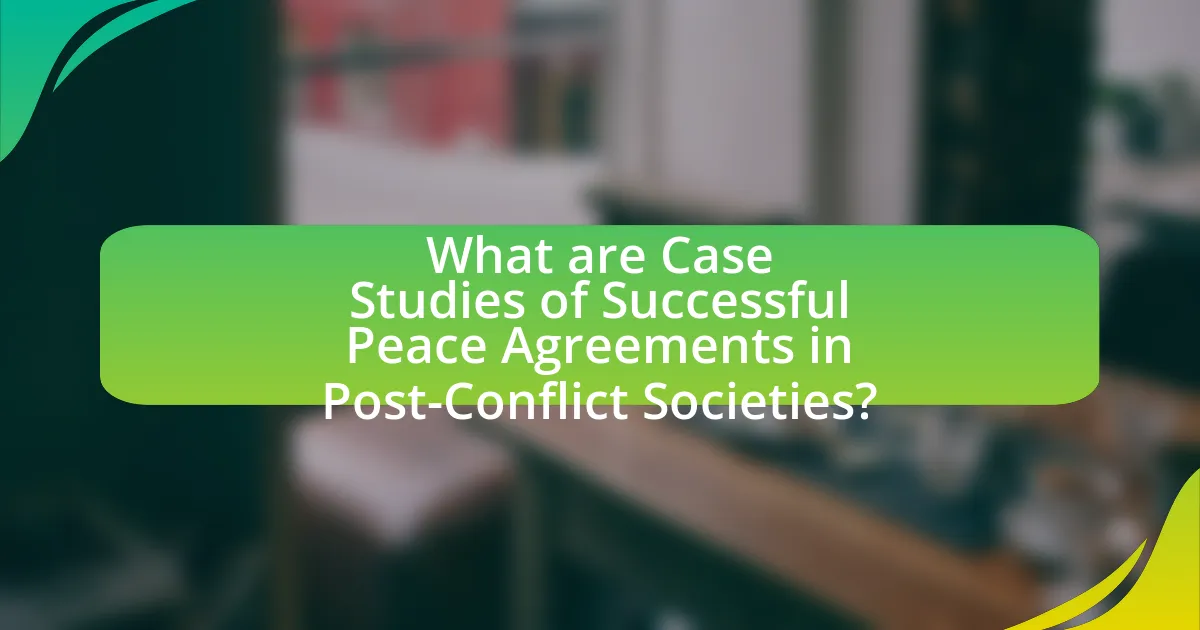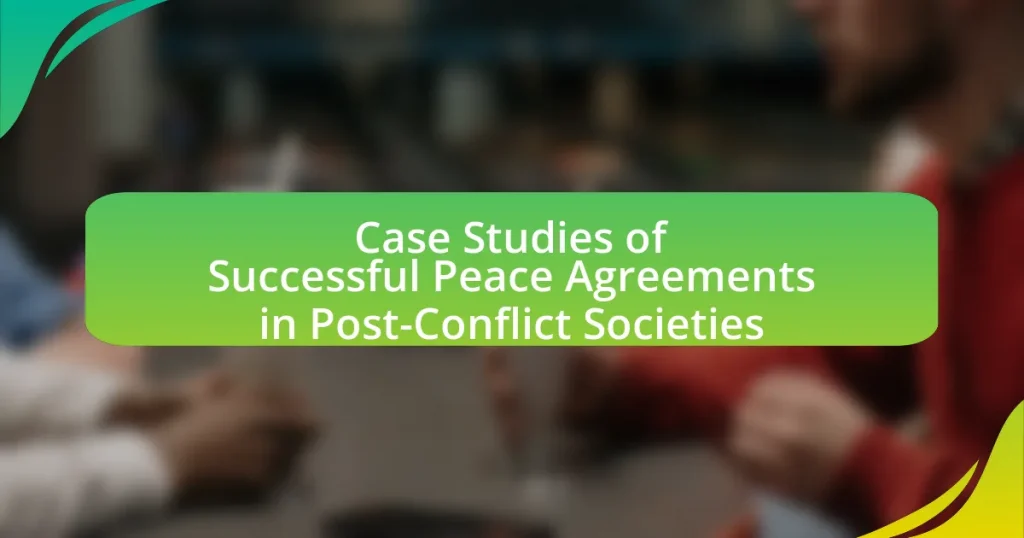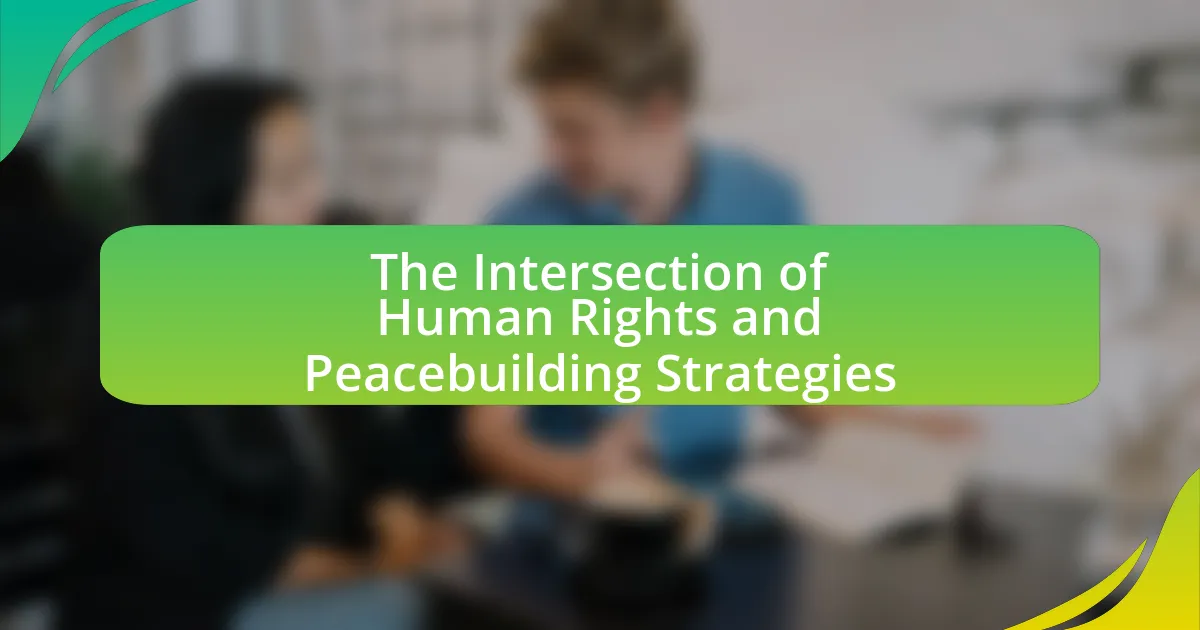The article focuses on case studies of successful peace agreements in post-conflict societies, highlighting notable examples such as the 1995 Dayton Agreement in Bosnia and Herzegovina and the 2016 peace deal in Colombia. It emphasizes the significance of inclusive dialogue, international support, and addressing root causes of conflict in achieving lasting peace. The article also explores the importance of case studies in understanding peace agreements, the criteria for success, and the essential elements for sustainability. Additionally, it discusses the challenges faced during implementation, the role of local ownership, and the impact of cultural and historical contexts on peace processes.

What are Case Studies of Successful Peace Agreements in Post-Conflict Societies?
Case studies of successful peace agreements in post-conflict societies include the 1995 Dayton Agreement in Bosnia and Herzegovina, which ended the Bosnian War, and the 2016 peace deal in Colombia between the government and the FARC guerrilla group, which concluded over five decades of conflict. The Dayton Agreement established a framework for governance and ethnic representation, leading to a significant reduction in violence and the establishment of a multi-ethnic state. The Colombian peace deal, supported by international actors, included provisions for land reform, political participation, and transitional justice, resulting in a notable decrease in armed conflict and the reintegration of former combatants into society. Both cases demonstrate the importance of inclusive dialogue, international support, and addressing root causes of conflict in achieving lasting peace.
Why are case studies important in understanding peace agreements?
Case studies are important in understanding peace agreements because they provide detailed, contextual insights into the processes, challenges, and outcomes of specific agreements. By examining real-world examples, researchers can identify patterns and factors that contribute to the success or failure of peace initiatives. For instance, the Good Friday Agreement in Northern Ireland illustrates how inclusive dialogue and power-sharing arrangements can lead to lasting peace, while the failure of the 1994 Arusha Accords in Rwanda highlights the consequences of inadequate implementation and lack of commitment from key stakeholders. These concrete examples allow scholars and practitioners to draw lessons that inform future peacebuilding efforts, making case studies a vital tool in the analysis of peace agreements.
What insights can we gain from analyzing specific peace agreements?
Analyzing specific peace agreements provides insights into the mechanisms that facilitate conflict resolution and sustainable peace. These agreements often reveal the importance of inclusive negotiation processes, as seen in the Good Friday Agreement, which involved multiple stakeholders, including political parties and civil society, leading to a more comprehensive and accepted resolution. Additionally, examining the implementation phases of peace agreements, such as the Dayton Accords, highlights the necessity of monitoring and support from international actors to ensure compliance and address emerging challenges. Furthermore, case studies demonstrate that successful peace agreements often incorporate provisions for transitional justice, which can help address grievances and foster reconciliation, as evidenced by the South African Truth and Reconciliation Commission.
How do case studies contribute to the field of conflict resolution?
Case studies contribute to the field of conflict resolution by providing detailed analyses of specific instances where peace agreements have been successfully implemented in post-conflict societies. These case studies allow researchers and practitioners to identify effective strategies, understand the dynamics of negotiation, and evaluate the outcomes of various approaches. For example, the case study of the Good Friday Agreement in Northern Ireland illustrates how inclusive dialogue and power-sharing arrangements can lead to sustainable peace, highlighting the importance of addressing underlying grievances. Such concrete examples serve as valuable learning tools, enabling stakeholders to adapt successful elements to different contexts and improve future conflict resolution efforts.
What criteria define a successful peace agreement?
A successful peace agreement is defined by its ability to address the root causes of conflict, establish mechanisms for conflict resolution, and ensure the participation of all relevant stakeholders. Effective peace agreements typically include provisions for power-sharing, security arrangements, and the protection of human rights, which are essential for fostering trust among conflicting parties. Historical examples, such as the Good Friday Agreement in 1998, demonstrate that inclusive dialogue and comprehensive frameworks can lead to lasting peace by addressing grievances and promoting cooperation among diverse groups.
What elements are essential for the sustainability of peace agreements?
Essential elements for the sustainability of peace agreements include inclusivity, effective implementation mechanisms, and ongoing dialogue. Inclusivity ensures that all relevant stakeholders, including marginalized groups, are represented, which fosters broader support and legitimacy. Effective implementation mechanisms, such as clear timelines and accountability measures, are crucial for translating agreements into action, as seen in the 1996 peace agreement in Guatemala, which included specific benchmarks for progress. Ongoing dialogue allows for the adaptation of agreements to changing circumstances, as demonstrated by the peace process in Colombia, where continuous engagement has been vital for addressing emerging challenges.
How do we measure the success of a peace agreement in post-conflict societies?
The success of a peace agreement in post-conflict societies is measured through several key indicators, including the durability of peace, the level of political stability, and the extent of social and economic recovery. Durability of peace is assessed by the absence of renewed violence or conflict, which can be quantified through statistical data on conflict incidents over time. Political stability is evaluated by the establishment of effective governance structures and the legitimacy of political institutions, often measured through public opinion surveys and electoral participation rates. Social and economic recovery is gauged by improvements in living standards, access to basic services, and economic growth metrics, such as GDP growth rates and employment statistics. These indicators collectively provide a comprehensive framework for assessing the effectiveness and sustainability of peace agreements in post-conflict contexts.
What are some notable examples of successful peace agreements?
Notable examples of successful peace agreements include the Camp David Accords of 1978, which established peace between Egypt and Israel, and the Good Friday Agreement of 1998, which helped to end the conflict in Northern Ireland. The Camp David Accords, brokered by U.S. President Jimmy Carter, resulted in Egypt recognizing Israel and Israel withdrawing from the Sinai Peninsula. The Good Friday Agreement, signed by the British and Irish governments along with political parties in Northern Ireland, created a devolved government and addressed issues of identity and governance, significantly reducing violence in the region.
What lessons can be learned from the Good Friday Agreement?
The Good Friday Agreement teaches the importance of inclusive dialogue in peace processes. This agreement, signed in 1998, involved multiple stakeholders, including political parties from both nationalist and unionist communities, demonstrating that broad participation fosters legitimacy and acceptance. Additionally, the agreement highlights the necessity of addressing underlying grievances, as it incorporated provisions for civil rights and equality, which were crucial for long-term stability. The successful implementation of power-sharing arrangements further illustrates that balancing interests can lead to sustained peace, as evidenced by the establishment of the Northern Ireland Assembly. These lessons underscore that comprehensive engagement, addressing root causes, and creating equitable governance structures are vital for successful peace agreements in post-conflict societies.
How did the Dayton Agreement reshape Bosnia and Herzegovina?
The Dayton Agreement reshaped Bosnia and Herzegovina by establishing a framework for peace that ended the Bosnian War and created a complex political structure. This agreement, signed in December 1995, divided the country into two entities: the Federation of Bosnia and Herzegovina and the Republika Srpska, each with its own government. The agreement also mandated the establishment of a central government and a multi-ethnic parliament, promoting power-sharing among the country’s three main ethnic groups: Bosniaks, Croats, and Serbs. The implementation of the Dayton Agreement led to significant changes in governance, security, and international oversight, including the presence of NATO forces to maintain peace. The agreement’s provisions aimed to ensure stability and prevent further ethnic conflict, fundamentally altering the political landscape of Bosnia and Herzegovina.
How do these case studies inform future peace processes?
Case studies of successful peace agreements in post-conflict societies provide critical insights for future peace processes by highlighting effective strategies and common challenges. For instance, the Good Friday Agreement in Northern Ireland demonstrates the importance of inclusive dialogue among all stakeholders, which can lead to sustainable peace. Additionally, the peace process in South Africa illustrates the necessity of addressing underlying social inequalities to foster long-term stability. These examples show that tailored approaches, considering local contexts and historical grievances, significantly enhance the likelihood of successful peace outcomes.
What challenges do post-conflict societies face in implementing peace agreements?
Post-conflict societies face significant challenges in implementing peace agreements, primarily due to issues such as lack of trust among conflicting parties, weak governance structures, and socio-economic instability. The absence of trust can lead to reluctance in adhering to the terms of the agreement, as seen in the case of the 1996 peace agreement in Guatemala, where deep-seated mistrust hindered effective implementation. Weak governance structures often result in inadequate enforcement mechanisms, making it difficult to uphold the commitments made in peace agreements. Additionally, socio-economic instability can exacerbate tensions, as seen in the Democratic Republic of the Congo, where poverty and unemployment have undermined peace efforts. These factors collectively impede the successful implementation of peace agreements in post-conflict settings.

What factors contribute to the success of peace agreements?
The success of peace agreements is primarily influenced by the inclusion of all relevant stakeholders in the negotiation process. When diverse groups, including government representatives, opposition factions, and civil society, participate, the agreements tend to be more comprehensive and widely accepted. For instance, the 1995 Dayton Agreement, which ended the Bosnian War, involved multiple parties and addressed various political, territorial, and social issues, leading to a more sustainable peace. Additionally, the presence of international mediators can enhance credibility and provide necessary resources, as seen in the 2016 Colombian peace deal, where international support helped facilitate dialogue and implementation. Furthermore, addressing underlying grievances and ensuring mechanisms for accountability and justice are crucial, as evidenced by the Truth and Reconciliation Commission established in South Africa post-apartheid, which aimed to heal societal divisions.
How does local ownership influence the effectiveness of peace agreements?
Local ownership significantly enhances the effectiveness of peace agreements by ensuring that the involved communities actively participate in the negotiation and implementation processes. When local stakeholders are engaged, they are more likely to support and adhere to the terms of the agreement, as it reflects their interests and needs. For instance, the 1995 Dayton Agreement in Bosnia and Herzegovina demonstrated that local involvement in peacebuilding efforts led to more sustainable outcomes, as local leaders were integral in fostering trust and cooperation among diverse ethnic groups. Research by the United Nations Development Programme indicates that peace agreements with strong local ownership have a higher likelihood of lasting success, as they empower communities to take responsibility for their own peace and stability.
What role do local leaders play in the peace process?
Local leaders play a crucial role in the peace process by acting as intermediaries between communities and external peacebuilding entities. They facilitate dialogue, build trust, and mobilize local support for peace initiatives, which is essential for sustainable conflict resolution. For instance, in the case of the 1996 peace agreement in Guatemala, local leaders were instrumental in representing indigenous communities, ensuring their voices were heard in negotiations. Their involvement helped to address local grievances and fostered a sense of ownership over the peace process, which is vital for its long-term success.
How can community involvement enhance the legitimacy of peace agreements?
Community involvement enhances the legitimacy of peace agreements by fostering local ownership and ensuring that the agreements reflect the needs and aspirations of the affected populations. When communities actively participate in the peace process, they contribute valuable insights that can lead to more inclusive and representative agreements. For instance, the 1996 peace agreement in Guatemala involved extensive consultations with indigenous communities, which helped address historical grievances and resulted in a more widely accepted framework for peace. This participatory approach not only builds trust among stakeholders but also increases the likelihood of sustainable implementation, as communities feel a sense of responsibility and commitment to uphold the agreements.
What external factors impact the success of peace agreements?
External factors that impact the success of peace agreements include international support, regional stability, and the involvement of third-party mediators. International support, such as financial aid and diplomatic backing, can enhance the legitimacy and implementation of peace agreements, as seen in the 1995 Dayton Accords for Bosnia, which received significant backing from the United States and NATO. Regional stability is crucial; for instance, the peace agreement in El Salvador in 1992 was facilitated by a stable Central American region, which reduced the likelihood of spillover conflicts. Additionally, the role of third-party mediators, like the United Nations in the peace process in South Sudan, can provide neutral ground for negotiations and help ensure compliance with the terms of the agreement.
How do international organizations support peace processes?
International organizations support peace processes by facilitating negotiations, providing mediation, and offering technical assistance. For instance, the United Nations often deploys peacekeeping missions to maintain stability and create a conducive environment for dialogue. Additionally, organizations like the African Union and the European Union engage in diplomatic efforts to bring conflicting parties together, exemplified by the African Union’s role in mediating the peace agreement in South Sudan in 2015. These organizations also provide resources and expertise in areas such as disarmament, demobilization, and reintegration of combatants, which are crucial for sustainable peace.
What is the significance of foreign aid in post-conflict reconstruction?
Foreign aid is significant in post-conflict reconstruction as it provides essential resources for rebuilding infrastructure, restoring governance, and promoting economic stability. This assistance helps to address immediate humanitarian needs, such as food, healthcare, and shelter, while also facilitating long-term development initiatives. For instance, the United Nations Development Programme reported that countries receiving foreign aid during their reconstruction phases, such as Rwanda and Bosnia, experienced faster recovery and stabilization compared to those that did not receive similar support. This demonstrates that foreign aid plays a crucial role in fostering peace and preventing the resurgence of conflict by enabling societies to rebuild effectively and sustainably.
How do cultural and historical contexts affect peace agreements?
Cultural and historical contexts significantly influence peace agreements by shaping the values, beliefs, and expectations of the parties involved. For instance, in the Good Friday Agreement of 1998, the historical grievances between Catholics and Protestants in Northern Ireland were acknowledged, allowing for a more inclusive dialogue that addressed the root causes of conflict. Additionally, cultural norms can dictate the methods of negotiation and the acceptance of compromise; in many Indigenous cultures, consensus-building is preferred over adversarial approaches, which can lead to more sustainable agreements. Historical narratives also play a crucial role, as they can either foster a sense of shared identity or perpetuate divisions, impacting the willingness of groups to engage in peace processes.
What role does historical grievance play in negotiations?
Historical grievance significantly influences negotiations by shaping the perceptions and motivations of the parties involved. These grievances often stem from past injustices, conflicts, or inequalities, which can lead to mistrust and hostility. For instance, in the case of the Good Friday Agreement in Northern Ireland, historical grievances related to sectarian violence and discrimination played a crucial role in the negotiation process, as both sides had to address these deep-seated issues to reach a sustainable peace. Acknowledging and addressing historical grievances can facilitate dialogue, promote empathy, and ultimately lead to more effective conflict resolution strategies.
How can cultural understanding facilitate better peace outcomes?
Cultural understanding can facilitate better peace outcomes by fostering empathy and reducing misunderstandings among conflicting parties. When individuals recognize and appreciate each other’s cultural backgrounds, it leads to more effective communication and collaboration. For instance, the peace process in South Africa during the 1990s demonstrated that acknowledging the diverse cultural identities of various groups helped build trust and cooperation, ultimately leading to a successful transition from apartheid to a democratic society. This cultural sensitivity was crucial in negotiating terms that respected the rights and traditions of all communities involved, thereby enhancing the legitimacy and acceptance of the peace agreement.

What are the common pitfalls in peace agreements?
Common pitfalls in peace agreements include lack of inclusivity, insufficient enforcement mechanisms, and failure to address root causes of conflict. Lack of inclusivity often leads to the marginalization of key stakeholders, which can result in ongoing tensions and resentment, as seen in the 1995 Dayton Agreement for Bosnia, where certain ethnic groups felt excluded. Insufficient enforcement mechanisms can render agreements ineffective; for instance, the 2000 peace agreement in Sierra Leone struggled due to weak international oversight. Additionally, failure to address underlying issues, such as economic disparities or historical grievances, can lead to a resurgence of violence, as evidenced by the 2011 peace deal in South Sudan, which did not adequately resolve ethnic divisions.
What are the most frequent reasons for the failure of peace agreements?
The most frequent reasons for the failure of peace agreements include lack of commitment from key parties, insufficient enforcement mechanisms, and failure to address underlying grievances. Lack of commitment often arises when parties do not genuinely intend to uphold the terms, leading to violations. Insufficient enforcement mechanisms can result in a lack of accountability, allowing parties to disregard the agreement without consequences. Additionally, failure to address underlying grievances, such as social, economic, or political inequalities, can lead to renewed conflict, as unresolved issues continue to fuel tensions. Historical examples, such as the failure of the 1993 Oslo Accords between Israel and Palestine, illustrate these points, where lack of trust and commitment hindered progress towards lasting peace.
How does lack of trust among parties lead to breakdowns in agreements?
Lack of trust among parties leads to breakdowns in agreements by fostering suspicion and fear, which undermine collaboration and commitment. When parties do not trust each other, they are less likely to share critical information or adhere to the terms of the agreement, fearing exploitation or betrayal. This distrust can manifest in behaviors such as non-compliance, miscommunication, and reluctance to engage in negotiations, ultimately resulting in the failure of the agreement. Historical examples, such as the Oslo Accords between Israel and the Palestine Liberation Organization, illustrate how mutual distrust hindered progress and led to repeated breakdowns in negotiations, demonstrating that trust is essential for the sustainability of agreements.
What impact does insufficient enforcement mechanisms have on peace sustainability?
Insufficient enforcement mechanisms significantly undermine peace sustainability by allowing violations of agreements to go unpunished. When parties to a peace agreement perceive that there are no consequences for breaking the terms, it fosters an environment of mistrust and can lead to a resurgence of conflict. For instance, in the case of the 1995 Dayton Agreement in Bosnia, weak enforcement of provisions related to military integration and political representation contributed to ongoing ethnic tensions and violence. This illustrates that without robust enforcement, the likelihood of maintaining lasting peace diminishes, as parties may revert to previous hostilities when they feel secure in their ability to act without repercussions.
How can these pitfalls be avoided in future agreements?
To avoid pitfalls in future agreements, stakeholders should prioritize inclusive dialogue and comprehensive stakeholder engagement. Research indicates that agreements involving diverse groups, including marginalized communities, lead to more sustainable outcomes. For instance, the 2016 Colombian peace agreement included extensive consultations with various societal sectors, which helped address potential grievances and foster broader support. Additionally, establishing clear mechanisms for monitoring and enforcement can mitigate misunderstandings and ensure compliance, as evidenced by the successful implementation of the Dayton Agreement in Bosnia, which included specific provisions for oversight.
What best practices can be implemented to enhance negotiation processes?
To enhance negotiation processes, establishing clear communication and mutual understanding is essential. Effective negotiators prioritize active listening, ensuring all parties feel heard and valued, which fosters trust and collaboration. Research indicates that negotiations with open dialogue lead to more satisfactory outcomes; for instance, a study by the Program on Negotiation at Harvard Law School highlights that successful negotiations often involve parties who engage in transparent discussions about their interests and concerns. Additionally, setting specific goals and objectives before negotiations can streamline the process, as evidenced by the Dayton Accords, where clear aims facilitated the resolution of the Bosnian War. Implementing these best practices can significantly improve the effectiveness of negotiation processes in various contexts, including post-conflict societies.
How can monitoring and evaluation improve peace agreement outcomes?
Monitoring and evaluation can significantly improve peace agreement outcomes by ensuring accountability and facilitating adaptive management. Effective monitoring allows stakeholders to track the implementation of peace agreements, identify challenges, and assess the impact of various initiatives. For instance, the United Nations has emphasized the importance of monitoring in peace processes, noting that systematic evaluation can lead to timely interventions that address emerging issues, thereby enhancing the sustainability of peace. Furthermore, studies have shown that peace agreements with robust monitoring mechanisms are more likely to be successfully implemented, as they foster trust among parties and encourage compliance with the terms of the agreement.
What practical steps can be taken to ensure successful peace agreements?
To ensure successful peace agreements, it is essential to engage all relevant stakeholders in the negotiation process. This inclusivity fosters trust and addresses the concerns of various groups, which is critical for long-term stability. For instance, the 1995 Dayton Agreement, which ended the Bosnian War, involved representatives from Bosnia, Croatia, and Serbia, ensuring that the voices of all parties were heard and considered. Additionally, establishing clear timelines and benchmarks for implementation can help maintain momentum and accountability, as seen in the 2000 peace agreement in Sierra Leone, which included specific milestones for disarmament and reintegration of combatants. Furthermore, incorporating mechanisms for conflict resolution and addressing grievances can prevent the resurgence of violence, as demonstrated by the peace process in Colombia, where transitional justice measures were integral to the agreement’s success.
What strategies can negotiators employ to build consensus?
Negotiators can employ strategies such as active listening, establishing common ground, and fostering open communication to build consensus. Active listening allows negotiators to understand the perspectives and concerns of all parties involved, which is crucial for addressing underlying issues. Establishing common ground helps to identify shared interests and goals, creating a foundation for collaboration. Fostering open communication encourages transparency and trust, enabling negotiators to navigate disagreements effectively. These strategies have been validated in various peace agreements, such as the Good Friday Agreement in Northern Ireland, where inclusive dialogue and mutual respect were essential in achieving consensus among conflicting parties.
How can lessons from past case studies guide current peace efforts?
Lessons from past case studies can guide current peace efforts by providing evidence-based strategies that have proven effective in resolving conflicts. For instance, the Good Friday Agreement in Northern Ireland illustrates the importance of inclusive dialogue and power-sharing arrangements, which helped to address the grievances of various factions. Additionally, the peace process in South Africa demonstrates the value of truth and reconciliation commissions in fostering societal healing and trust. These historical examples highlight the necessity of understanding local contexts, engaging all stakeholders, and implementing mechanisms for accountability, which are critical for the success of contemporary peace initiatives.





